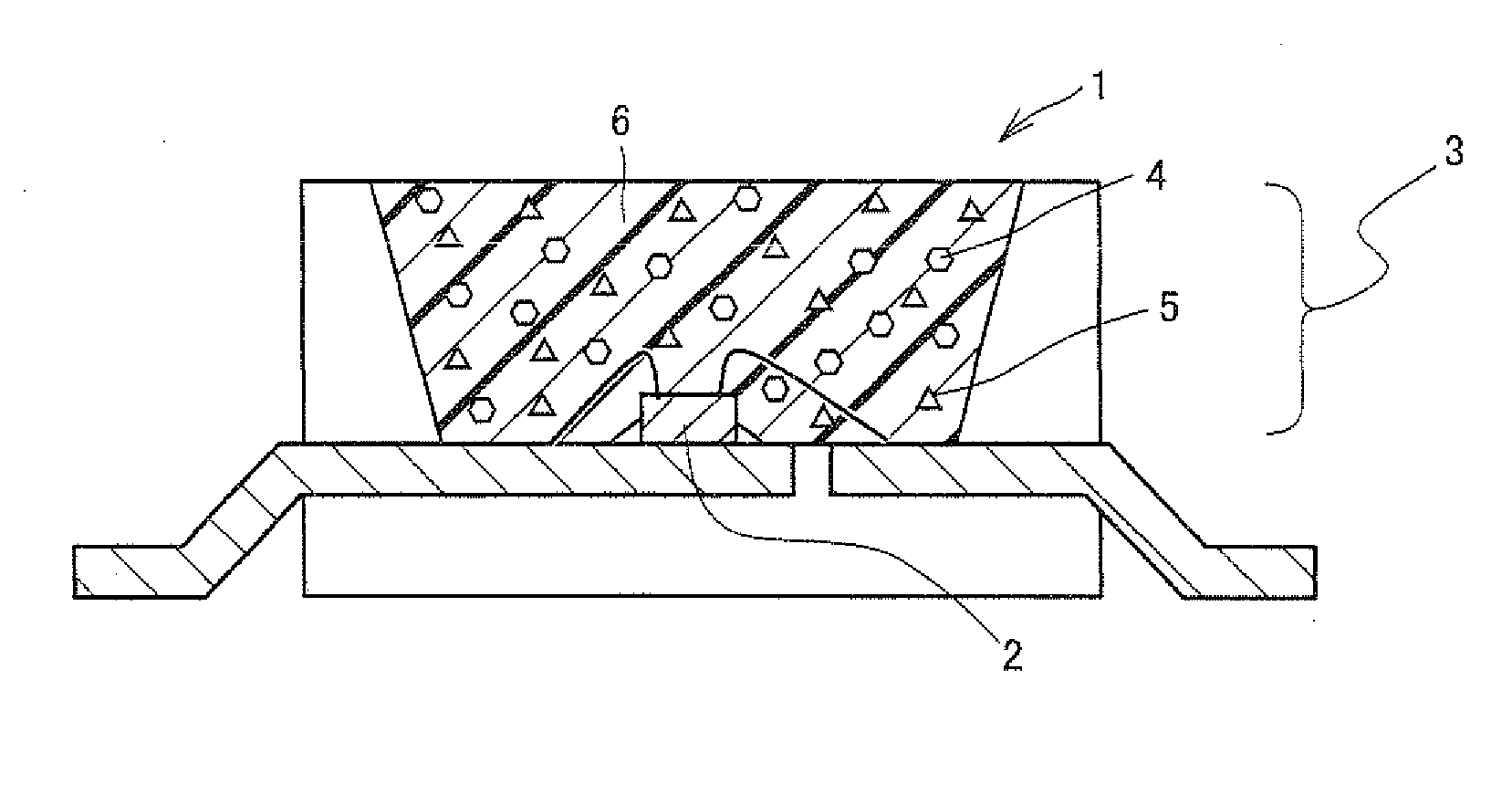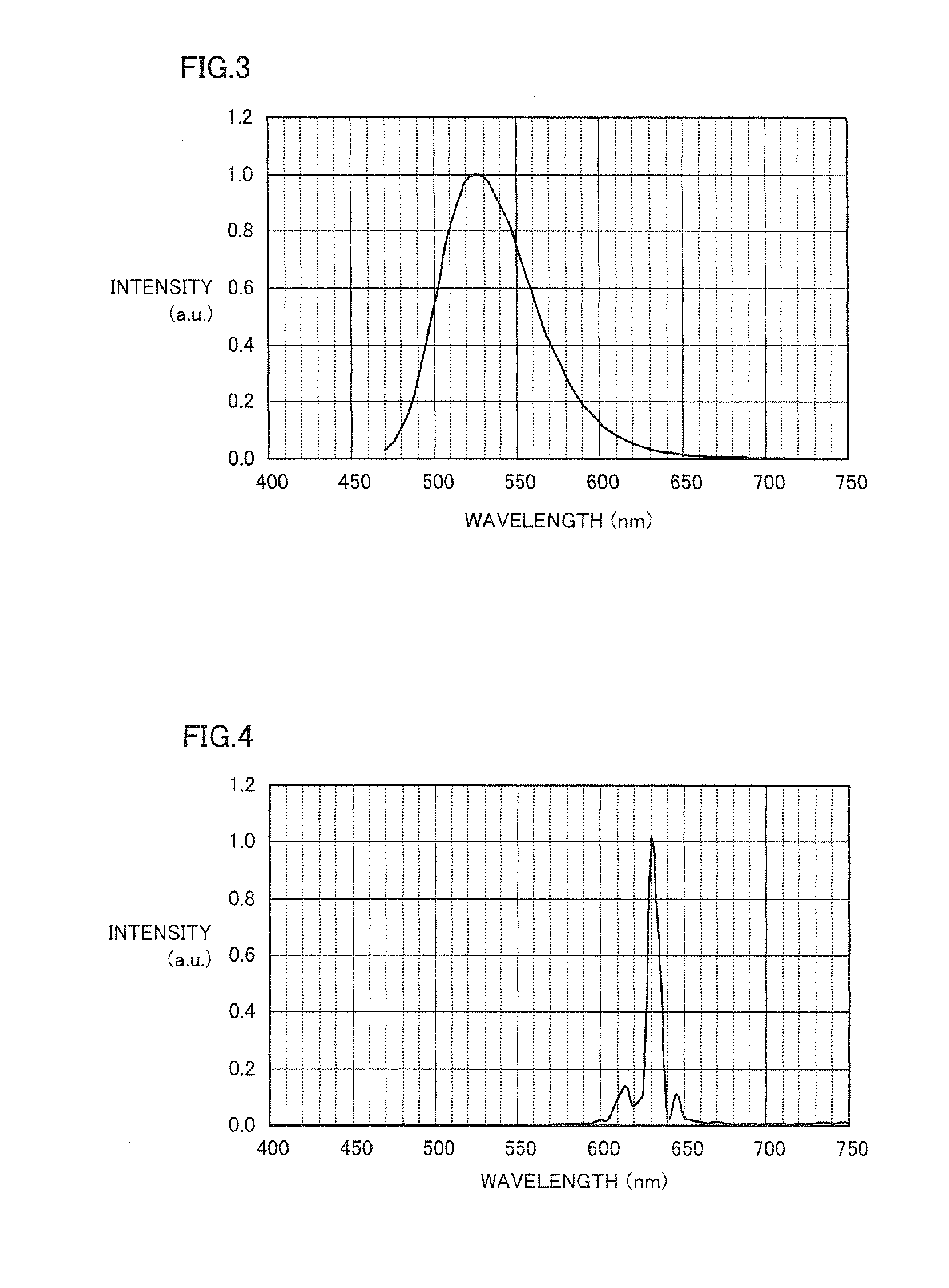Light-emitting device
a technology of light-emitting devices and light-emitting tubes, which is applied in the direction of discharge tubes/lamp details, instruments, luminescent screens of discharge tubes, etc., can solve the problems of not finding a method that can satisfy both brightness and achieves excellent color gamut (ntsc ratio), efficient light absorption and white light high efficiency
- Summary
- Abstract
- Description
- Claims
- Application Information
AI Technical Summary
Benefits of technology
Problems solved by technology
Method used
Image
Examples
example 1
[0050]Light-emitting device 1 of the example shown in FIG. 1 was fabricated in the following manner. As light-emitting element 2, a gallium nitride (GaN)-based semiconductor having a peak wavelength at 450 nm was used, and in light converter 3, Eu0.05Si11.50Al0.50O0.05N15.95 (β-type SiAlON) was used as a green light-emitting phosphor, and K2(Ti0.99Mn0.01)F6 was used as a red light-emitting phosphor. A 30:70 (weight ratio) mixture of these green light-emitting phosphor and red light-emitting phosphor was dispersed in a predetermined resin (ratio between a resin and a phosphor was 1.00:0.25) to fabricate a light converter. In this manner, a light-emitting device of Example 1 was fabricated.
example 2
[0054]A light-emitting device was fabricated in a similar manner as Example 1 except that a gallium nitride (GaN)-based semiconductor having a peak wavelength at 440 nm was used as light-emitting element 2, 2(Ba0.70Sr0.26Eu0.04)O.SiO2 was used as a green light-emitting phosphor, and K2(Ti0.995Mn0.005)F6 was used as a red light-emitting phosphor.
examples 3 to 8
, Comparative examples 3 to 8
[0058]Light-emitting devices of Examples 3 to 8 and Comparative examples 3 to were fabricated in a similar manner as Example 1 except that combinations of a peak wavelength of a light-emitting element and phosphors as shown in the following Table 3 were used respectively, and brightness, Tc-duv and color gamut (NTSC ratio) were evaluated in a similar manner as described above. Results are also shown in Table 3.
TABLE 3Light-emittingBrightnessColor gamutelementPhosphor(relative value)Tc-duv(NTSC ratio)Example 3430 nmGreen: Eu0.30Si9.80Al2.20O0.30N15.7096.6%9500K + 0.00186.4%Red: Na2(Ti0.895Zr0.100Mn0.005)F6Comparative430 nmYellow: 2(Sr0.92Ba0.06Eu0.02)O•SiO2100.0%9500K + 0.00167.4%example 3Example 4480 nmGreen: Eu0.15Si10.00Al2.00O0.20N15.8096.0%8800K + 0.00187.9%Red: Cs2(Ti0.79Si0.20Mn0.01)F6Comparative480 nmYellow: (Y0.40Gd0.40Ce0.20)3Al5O12100.0%8800K + 0.00170.0%example 4Example 5455 nmGreen: 2(Ba0.82Sr0.15Eu0.03)O•SiO296.4%8900K + 0.00288.0%Red: Cs2(T...
PUM
 Login to View More
Login to View More Abstract
Description
Claims
Application Information
 Login to View More
Login to View More - R&D
- Intellectual Property
- Life Sciences
- Materials
- Tech Scout
- Unparalleled Data Quality
- Higher Quality Content
- 60% Fewer Hallucinations
Browse by: Latest US Patents, China's latest patents, Technical Efficacy Thesaurus, Application Domain, Technology Topic, Popular Technical Reports.
© 2025 PatSnap. All rights reserved.Legal|Privacy policy|Modern Slavery Act Transparency Statement|Sitemap|About US| Contact US: help@patsnap.com



